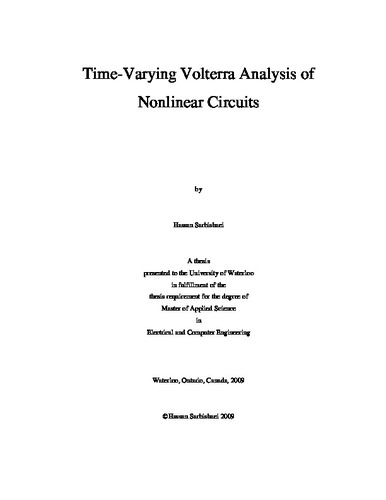| dc.contributor.author | Sarbishaei, Hassan | |
| dc.date.accessioned | 2009-05-22 17:19:12 (GMT) | |
| dc.date.available | 2009-05-22 17:19:12 (GMT) | |
| dc.date.issued | 2009-05-22T17:19:12Z | |
| dc.date.submitted | 2009 | |
| dc.identifier.uri | http://hdl.handle.net/10012/4451 | |
| dc.description.abstract | Today’s advances in communication systems and VLSI circuits increases the performance
requirements and complexity of circuits. The performance of RF and mixed-signal circuits is
normally limited by the nonlinear behavior of the transistors used in the design. This makes
simulation of nonlinear circuits more important. Volterra series is a method used for simulation of
mildly nonlinear circuits. Using Volterra series the response of the nonlinear circuit is converted into
a sum of multiple linear circuit responses. Thus, using Volterra series, simulation of nonlinear circuits
in frequency-domain analysis becomes possible. However, Volterra series is not able to simulate
strongly nonlinear circuits such as saturated Power Amplifiers.
In this thesis, a new time-varying Volterra analysis is presented. The time-varying Volterra
analysis is the generalization of conventional Volterra analysis where instead of using a DC
expansion point a time-varying waveform has been used. Employing a time-varying expansion
waveform for Volterra analysis, time-varying Volterra achieves better accuracy than conventional
Volterra. The time-varying expansion waveforms are derived using a fast pre-analysis of the circuit.
Using numerical examples, it has been shown that the time-varying Volterra is capable of simulating
nonlinear circuits with better accuracy than conventional Volterra analysis. The time-varying Volterra
analysis in both time and frequency domains are discussed in this thesis. The time-varying Volterra
analysis has been used to simulate a saturated Class-F Power Amplifier in frequency-domain. The
simulation results show good agreement with ELDO® steady-state and Harmonic Balance simulation
results.
The proposed method manages to simulate nonlinear circuits, such as saturated Power Amplifier,
mixers and nonlinear microwave circuits, with good accuracy. Also, this method can be used to
simulate circuit with large number of nonlinear elements without the convergence issues of Harmonic Balance. | en |
| dc.language.iso | en | en |
| dc.publisher | University of Waterloo | en |
| dc.subject | Circuit Simulation | en |
| dc.subject | Nonlinear Circuits | en |
| dc.subject | Volterra Series | en |
| dc.title | Time-Varying Volterra Analysis of Nonlinear Circuits | en |
| dc.type | Master Thesis | en |
| dc.pending | false | en |
| dc.subject.program | Electrical and Computer Engineering | en |
| uws-etd.degree.department | Electrical and Computer Engineering | en |
| uws-etd.degree | Master of Applied Science | en |
| uws.typeOfResource | Text | en |
| uws.peerReviewStatus | Unreviewed | en |
| uws.scholarLevel | Graduate | en |

